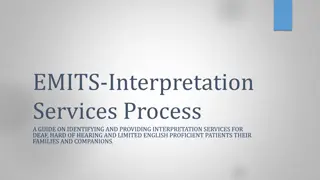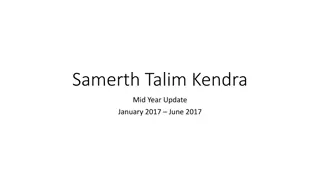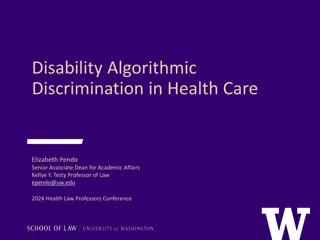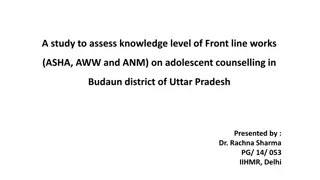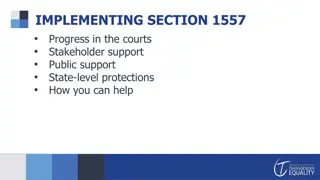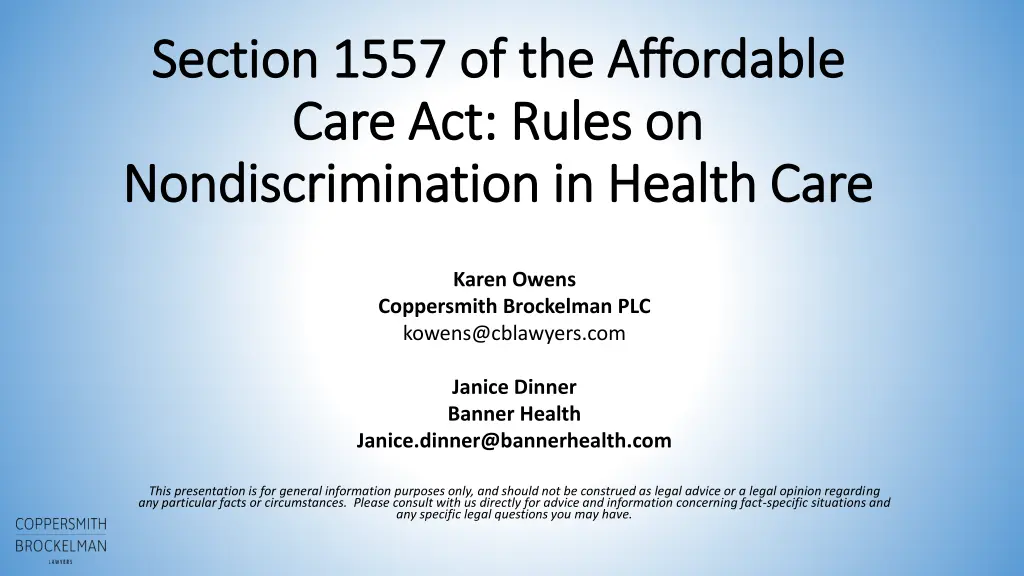
Rules on Nondiscrimination in Health Care under Section 1557 of the Affordable Care Act
Understand the background, applicability, effective dates, and assurance of compliance regarding Section 1557 of the Affordable Care Act, which prohibits discrimination in health care based on race, color, national origin, sex, age, or disability. Learn which health programs and activities must follow these rules and the requirements for compliance with federal regulations.
Download Presentation

Please find below an Image/Link to download the presentation.
The content on the website is provided AS IS for your information and personal use only. It may not be sold, licensed, or shared on other websites without obtaining consent from the author. If you encounter any issues during the download, it is possible that the publisher has removed the file from their server.
You are allowed to download the files provided on this website for personal or commercial use, subject to the condition that they are used lawfully. All files are the property of their respective owners.
The content on the website is provided AS IS for your information and personal use only. It may not be sold, licensed, or shared on other websites without obtaining consent from the author.
E N D
Presentation Transcript
Section 1557 of the Affordable Section 1557 of the Affordable Care Act: Rules on Care Act: Rules on Nondiscrimination in Health Care Nondiscrimination in Health Care Karen Owens Coppersmith Brockelman PLC kowens@cblawyers.com Janice Dinner Banner Health Janice.dinner@bannerhealth.com This presentation is for general information purposes only, and should not be construed as legal advice or a legal opinion regarding any particular facts or circumstances. Please consult with us directly for advice and information concerning fact-specific situations and any specific legal questions you may have.
Background Rules implement ACA Section 1557 Section 1557 prohibits discrimination based on race, color, national origin, sex, age, or disability in certain health programs Section 1557 has been enforced since 2010 None of the recent ACA repeal bills would have repealed Section 1557 Rules issued in May 2016; now under revision
Effective dates Compliance deadlines in regulations Generally applicable 7/18/16 Changes in provisions relating to health insurance or group health plan benefit design: Effective first day of first plan year beginning on or after 1/1/17 Notice requirement effective 10/16/16
Applicability of the 1557 rules Who has to follow the rules? Health programs/activities that receive any federal financial assistance from HHS E.g., hospitals that accept Medicare Applies to hospitals employee health plans as well But Medicare Part B is not federal financial assistance Health programs/activities administered by an ACA Title I entity ACA Title I entities: Health insurance marketplaces (state-based or federally facilitated) Health programs/activities administered by HHS Assurance of compliance Applicants for federal grants, loans, contact, property, discounts, an other federal financial assistance from ADHS must submit ASSURANCE OF COMPLIANCE WITH TITLE VI OF THE CIVIL RIGHTS ACT OF 1964, SECTION 504 OF THE REHABILITATION ACT OF 1973, TITLE IX OF THE EDUCATION AMENDMENTS OF 1972, THE AGE DISCRIMINATION ACT OF 1975, AND SECTION 1557 OF THE AFFORDABLE CARE ACT
Sex discrimination rules not enforced Nationwide permanent injunction issued in Franciscan Alliance v. Burwell, 2016 WL 7638311 (N.D. Texas 2016) Regulation conflicted with Title IX s prohibition on sex discrimination by including gender identity Failure to include Title IX s religious and abortion exemptions in regulation rendered the regulation arbitrary, capricious, and contrary to law in violation of APA Likely success on claim of violation of Religious Freedom Restoration Act (RFRA)
LGBTQ protections expected to be removed DHHS is drafting new sex discrimination regulations: expected to remove LGBTQ protections Donald Trump s Deputies Removing Pro-Transgender Rule from Obamacare May 18, 2017
On the other hand Other laws may take up some of the slack, e.g., Title VII, Civil Rights Act of 1964 Title IX, Education Amendments of 1972
Sex discrimination: todays rule Equal program access without discrimination on the basis of sex First federal civil rights law to address sex discrimination specifically in health programs and activities. Sex discrimination includes discrimination on the basis of: Pregnancy False pregnancy Termination of, or recovery from, pregnancy (but abortion is treated separately) Childbirth and related medical conditions Sex stereotyping Gender identity: transgender discrimination is expressly addressed
Disability discrimination Incorporates existing civil rights laws, but mandates more specific requirements for accessibility Entities must comply with specific prohibitions on discrimination under Section 504 of the Rehabilitation Act of 1973 regs. General prohibition on discrimination Cannot deny services or benefits on the basis of disability Cannot discriminate on the basis of disability in providing or administering health-related insurance Cannot deny insurance plan or policy, deny or limit coverage or claim, impose additional cost sharing, etc.
Disability discrimination Effective Communication Must take appropriate steps to ensure communications with individuals with disabilities are as effective as communications with others Must provide appropriate auxiliary aids and services to persons with impaired sensory, manual, or speaking skills, where necessary to afford equal opportunity to benefit from a service Buildings/Facilities Construction or alterations started after 7/18/16 must comply with the 2010 ADA Standards for Accessible Design (28 C.F.R. 35.104) (unless the entity was not already subject to these standards at that time, in which case the compliance deadline is later)
Disability discrimination Electronic and Information Technology Health programs or activities provided through electronic and information technology must be accessible to individuals with disabilities Unless it would cause undue financial and administrative burdens, or a fundamental alteration in the nature of the programs or activities In that case, must provide information in a non-electronic format that would ensure, as much as possible, that individuals receive the benefits or services of the program/activity Must ensure health programs and activities provided through websites comply with Title II of the ADA Regulations implementing ADA Title II: 28 C.F.R. Part 35 DOJ SANPRM on web accessibility: 81 Fed. Reg. 28658 (May 9, 2016)
Disability discrimination Modifications to Policies Must make reasonable modifications to policies, practices, or procedures when necessary to avoid disability discrimination, unless entity can demonstrate that making the modifications would fundamentally alter the nature of the program or activity Reasonable modifications interpreted as under ADA Title II regulation
Accessibility for Persons with Limited English Proficiency
Accessibility for individuals with limited English proficiency (LEP) Incorporates existing civil rights laws, but mandates more specific requirements for accessibility Entities must comply with specific prohibitions on discrimination under Title VI of the Civil Rights Act of 1964 regs. General Prohibition on Discrimination Cannot deny services or benefits on the basis of natl. origin Cannot discriminate on the basis of natl. origin in providing or administering health-related insurance
Accessibility for individuals with LEP General Access Requirement: Entities must take reasonable steps to provide meaningful access to individuals with limited English proficiency Language assistance services required must be: Free Accurate and timely Protect the privacy and independence of the individual Must offer qualified interpreter when oral interpretation is a reasonable step to provide meaningful access for that individual
Accessibility for individuals with LEP Must use a qualified translator when translating written content Must not require an individual to provide his or her own interpreter Entity cannot rely on interpretation/facilitation of communication by: an adult accompanying the individual, except in an emergency (with no qualified interpreter available) or if the individual specifically requests it and the adult agrees a minor, except in an emergency (with no qualified interpreter available) Staff, other than qualified bilingual/multilingual staff Specific requirements for video remote interpreting services OCR encourages development of a language access plan, which will be considered in evaluation of compliance
Accessibility for individuals with LEP OCR Guidance (August 2016) Top 15 languages spoken in each state Arizona Spanish Navajo Chinese Vietnamese Arabic Tagalog (spoken in the Philippines) Korean French German Russian Japanese Persian (Farsi) Syriac Serbo-Croatian Thai
Notice requirements Must comply by October 16, 2016 (90 days after effective date) Notice must inform reader that: Entity does not discriminate on the basis of race, color, national origin, sex, age, or disability Entity provides appropriate auxiliary aids and services free of charge Entity provide language assistance services free of charge How to obtain the aids and services The designated responsible employee Grievance procedure information How to file a discrimination complaint with the OCR
Notice requirements Covered entity/program must post full notice, and taglines in top 15 languages, in: Significant publications and significant communications targeted to beneficiaries, enrollees, applicants, and the public, except for small-sized communications Conspicuous physical locations where entity interacts with the public Conspicuous location on web site, accessible from the home page
Notice requirements For significant publications and significant communications that are small-sized, such as postcards and tri-fold brochures, entity is only required to post: Nondiscrimination statement Taglines in top 2 languages
Notice requirements All notices must be in conspicuously-visible font size Sample notice and tagline published at 45 C.F.R. Part 92, Appendices A and B Sample notice: www.hhs.gov/sites/default/files/sample-ce- notice-english.pdf Sample taglines: www.hhs.gov/civil-rights/for- individuals/section-1557/translated-resources/index.html
Section 1557 Coordinator/ Grievance Procedures
Coordinator/grievance procedures Entities/programs that employ 15 or more persons must designate a Section 1557 Coordinator Coordinates compliance efforts and carries out responsibilities including investigation or grievances
Coordinator/grievance procedures Coordinator also: Adopts written grievance procedures Include due process standards Provide for prompt and equitable resolution of grievances Allow grievance for allegations of any violation of Section 1557/regs
Coordinator/grievance procedures Appendix C to regulations: sample Grievance Procedure www.hhs.gov/sites/default/files/section-1557-sample-grievance-procedure.pdf Gives person 60 days after awareness of alleged violation to submit in writing; Coordinator has 30 days from filing to issue decision All interested persons may give evidence; confidential Appeal to Administrator/Board/etc. by letter What about grievances involving Medical Staff processes?
Citations Section 1557 of the Affordable Care Act: 42 U.S.C. 18116 http://housedocs.house.gov/energycommerce/ppacacon.pdf Final regulations: 45 C.F.R. 92.1 et seq. Preamble to final regulations: 81 F.R. 31375 https://www.federalregister.gov/documents/2016/05/18/2016- 11458/nondiscrimination-in-health-programs-and-activities Office for Civil Rights materials http://www.hhs.gov/civil-rights/for-individuals/section-1557/











